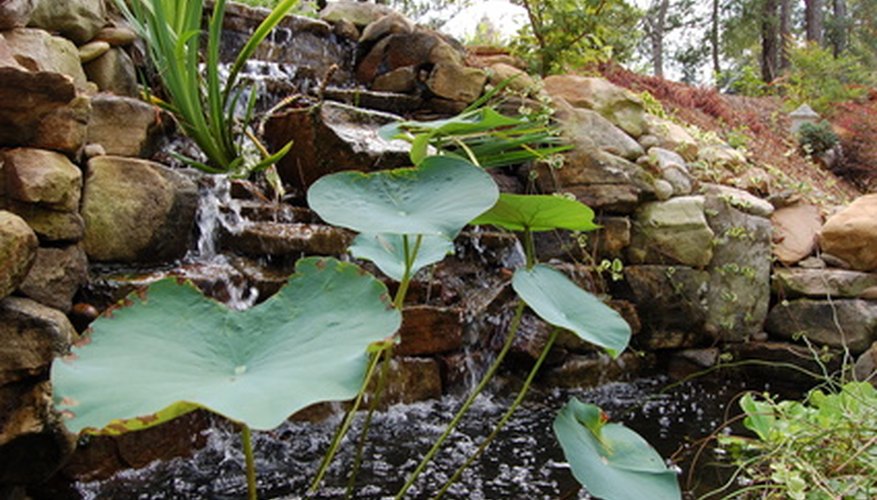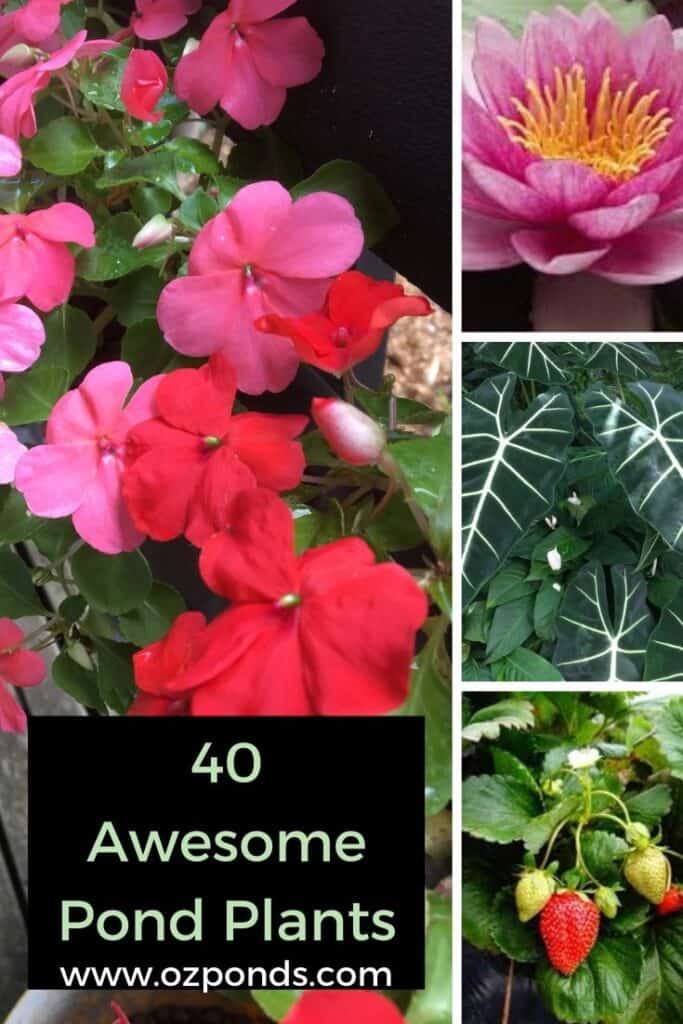Absolutely. The majority of your pond plants can be planted directly into the rocks and gravel of the pond.
In this way, they can get nitrates and other nutrients from the water instead of the potting soil.
The only plants i don’t plant into the gravel and rocks are water lilies and lotus.
Traditionally, aquatic pond plants are grown in pots filled with a soil-based potting mix. However over time the decaying soil can muddy pond water and cause unpleasant odors. To avoid these downsides, many pond owners are now using hydroponic methods to grow vibrant pond plants without messy soil.
This guide explains the benefits of soilless pond plant culture and provides tips for successfully growing hydroponic water plants using different substrates like gravel, sand, perlite, or LECA clay pebbles. Ditch the dirt and enjoy crystal clear water with healthy hydroponic pond gardens!
Advantages of Soilless Pond Plant Growth
Switching to hydroponic culture offers these upsides:
- Keeps pond water cleaner and clearer since no soil particles can disperse
- Prevents foul odors from anaerobic soil breaking down
- Allows easy repositioning of plants since they aren’t rooted in heavy soil
- Encourages faster spreading of roots to draw more nutrients from the water
- Provides opportunity to decorate with colored gravels and pebbles
- Makes plant division, pruning and winter storage simpler without dealing with soil
- Gives pond plants constant access to nutrient-rich water
How Hydroponics for Pond Plants Works
Hydroponics involves growing plants without soil by transferring nutrients directly to the roots suspended in oxygenated water or moisture-retentive mediums like perlite or gravel.
There are two main approaches to soilless pond plant culture:
1. Rock/Gravel Substrate
In this method, pond plant pots and baskets are filled with different sizes of gravel, pebbles or lightweight expanded clay aggregates like Hydroton instead of potting soil The roots grow densely throughout the spaces within the aggregate, accessing water flowing between the particles.
2. Raft/Float Hydroponics
The plants are supported in holes cut into floating foam boards or plastic rafts. The roots dangle freely into the nutrient-rich water below. Airstones enrich the water with oxygen.
Both techniques work well to keep pond plants healthy and vibrant without soil. The biggest challenge is providing the correct mineral nutrition since traditional potting mixes offer nutrients. But with careful management, hydroponic culture grows amazing pond plants.
Growing Hydroponic Pond Plants Step-By-Step
Follow this method to plant water plants in gravel or pebble substrates
Choose Plants Suited to Hydroponics
Good options include marginal plants like taro, canna, umbrella palm, and papyrus. Many oxygenators like anacharis and most floating plants will adapt to soilless culture.
Select a Hydroponic Medium
Use an aggregate size that fits your plant basket or pot dimensions. Mixing different gravel sizes allows plant roots to wick up moisture held in the pores.
Add Medium to Plant Container
Fill pots 2/3 with thoroughly rinsed gravel, leaving room at the top for water circulation.
Prepare and Transplant Plants
Carefully remove from old soil, divide if needed, and rinse roots. Spread roots over medium surface and fill remaining space with aggregate.
Slowly Submerge
Gradually introduce to pond over 7-10 days, slowly lowering pot to acclimate plants.
Provide Adequate Nutrition
Use liquid fertilizers formulated for hydroponics since traditional substrates offer no nutrition.
Maintain Ideal Conditions
Circulate pond water to prevent stagnation. Perform regular water testing and quality adjustments as needed.
Hydroponic Media Options for Pond Plants
There are many substrate options to choose from:
-
Gravel – Use a size like aquarium gravel that won’t easily wash through pots. Mix various grains for moisture retention.
-
Pebbles – Attractive smooth river rocks or tumbled glass pebbles come in different colors to decorate.
-
Expanded clay – Clay pellets like Hydroton provide excellent aeration. Can be reused.
-
Lava rock – Lightweight porous lava rock helps oxygenate roots and holds some nutrients.
-
LECA – Lightweight expanded clay aggregate forms provideSimilar to Hydroton.
-
Perlite – Floating white perlite works for raft systems. It doesn’t compact over time.
Experiment to see which pond plants grow best in different hydroponic media options. Plants with fine hairy roots may prefer smaller particles and smooth rocks won’t abrade delicate root structures.
Caring for Hydroponic Pond Plants
-
Check plants daily at first for signs of stress and adjust conditions as needed.
-
Remove any dead leaves or debris to keep water clean.
-
Test water frequently and correct any nutrient deficiencies.
-
Perform regular partial water changes to replenish nutrients.
-
Change media if it starts to break down or restricts root growth.
-
Divide root-bound plants and repot in fresh substrate as needed.
Troubleshooting Hydroponic Pond Plant Issues
Slow growth – Low nutrients or oxygen. Test levels and make adjustments.
Root rot – Poor circulation or overcrowding. Improve water flow.
Algae buildup – Too much light or excess nutrients. Cover pots or do partial water change.
Leaf discoloration – Mobile nutrient deficiency. Confirm pH is 6-7.5 and supplement.
White crust – Hard water deposits. Do partial water changes with soft water.
Frequently Asked Questions About Soilless Pond Plants
What plants can be grown hydroponically in ponds?
Many marginal and oxygenating pond plants adapt well to hydroponic culture, including papyrus, taro, umbrella palm, canna, duckweed, parrot’s feather, and anacharis.
Is hydroponics cheaper than soil for pond plants?
The startup cost is comparable, but hydroponics saves long-term since aggregated materials can be reused and there are no soil replacements needed.
How often should you fertilize hydroponic pond plants?
Apply liquid hydroponic nutrients every 2-3 weeks during the growing season, and monthly for potted plants. Test regularly and adjust your schedule as needed.
What pH do hydroponic pond plants need?
The ideal pH range is 6.0-7.5. Measure frequently and use pond buffers to maintain pH, which affects nutrient availability.
Can you combine hydroponic and soil-based pond plants?
Yes, you can use a hybrid approach with some plants staying in soil and others converting to hydroponic culture.
Growing pond plants hydroponically takes a little practice, but allows you to enjoy the benefits of aquatic gardening without muddy water or smelly soil. The varieties of decorative aggregates and lack of mess open new possibilities for conveniently designing breathtaking pond landscapes.

Planting pond plants in gravel helps keep algae at bay
Algae needs sunlight and nutrients to thrive. There isn’t too much you can do about the sunlight, but we can restrict access to nutrients.
To begin, any organic material we add to the pond, such as potting soil, will break down and release nutrients into the water.
Algae is very opportunistic and fast growing.
Usually the first thing you notice is the water starts to go green.
This is fast growing single celled algae. If the algae with only one cell can’t control the nutrients, other, more advanced algae will start to grow.
So just by not using potting soil for the plants we are removing one potential source of nutrients.
Of course the fish will add nutrients.
As will leaves, dust and pollen that is blown into the pond.
All these things build up different levels of nitrogen.
There are special nitrifying bacteria that will help process the nitrogen.
This process is called the nitrogen cycle.
At the end of the process we are left with nitrate.
The only way to dilute or remove nitrate is through a water change or plants absorbing it.
I prefer the plants. It’s less effort. I am lazy!
Because there is no soil for the roots they absorb the nitrate from the water.
You want to aim for a good selection of plants.
If possible you want something active at all times. Another tip is to thin them and remove old plant material.
This will encourage new growth, which absorbs nutrients faster.
If you need some plant ideas, check out my 40 awesome pond plant article.

Why you shouldn’t plant water lilies and lotus in gravel
Lotus and water lilies are heavy feeders. So it can be tempting to plant them directly into the rocks and gravel.
But they are very aggressive!
The pond will become a giant pot. They will take over the whole pond!
Both grow from tubers. Throughout the growing season they multiply.
They need to be thinned out every one or two years.
Both go dormant in winter. So this is when you want to thin them out.
I don’t know about you, but I don’t wanna be in my pond in winter. Its cold!
It’s much easier to plant them in a lily basket or pot. Then I can pull that up and divid the tubers as necessary.
I like growing them in pots because I can add some potting soil to the pots. This Will give you better blooms and more leaves throughout the season.
I don’t grow lotus or lilies for their nutrient consuming abilities. I look at them more as ornamental.
I will say that the leaves do provide a lot of shade, which is very helpful in the summer.
Remember algae needs sunlight to thrive. Even though I don’t plant them to get rid of nutrients, they do still help keep algae away.
The shade also keeps the water temperature cooler. Algae prefers warm water.
